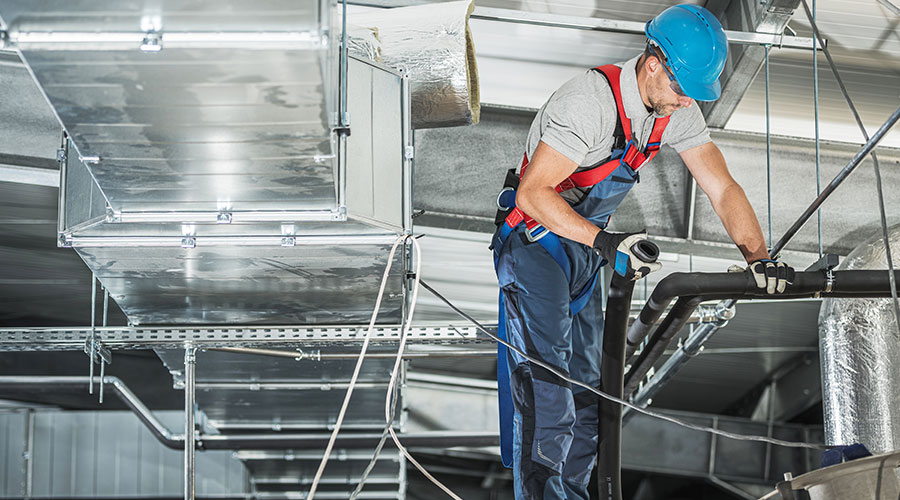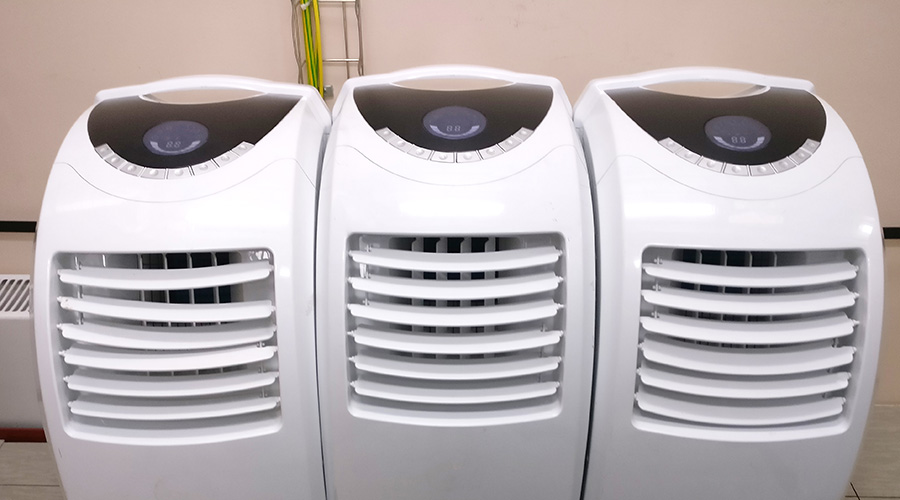Common HVAC Missteps and Myths
From neglected water treatment systems to misused CMMS platforms, HVAC manufacturers call out common mistakes and debunk widespread misconceptions
By Jeff Wardon, Jr., Assistant Editor
Planning maintenance schedules for HVAC components is one thing but executing them effectively is another. Maintenance and engineering managers may know their systems inside and out, but a number of issues at institutional and commercial facilities continue to occur.
In this manufacturer roundtable, Facility Maintenance Decisions spoke with HVAC manufacturers to break down where facilities are falling short and to set the record straight on what it takes to maintain HVAC systems for long-term performance and efficiency.
Roundtable participants include:
- Dave Schwaller, inside sales manager, DriSteem
- Kevin Cassidy, maintenance project manager, SSC Services for Education
- Buddy Saucier, VP, service operations/cross-domain harmonization, Johnson Controls
Q: What mistakes do facility departments make when planning their maintenance schedules?
SCHWALLER: "Many facility departments still rely on a reactive maintenance approach, waiting for failures to occur before acting. A key oversight is neglecting manufacturer-recommended inspection, testing and maintenance (ITM) schedules, particularly for humidity control systems. These systems are often viewed as secondary, yet they play a critical role in maintaining indoor air quality, protecting equipment and supporting occupant comfort. Similarly, water treatment systems are frequently ignored until visible scaling or system failure forces attention, but costly damage may already be done by then.
Pro tip: Make humidity control and water treatment a core part of your preventive maintenance plan. Routine inspection of dispersion panels, flushing of steam tanks and regular water quality testing can significantly improve system reliability, prevent performance decline and reduce unplanned service calls."
CASSIDY: "Most issues don’t arise during the planning phase but during execution. One of the biggest challenges is consistently sticking to the schedule — something that often falls apart when departments get busy or unexpected projects arise.
A major contributing factor is the improper use or neglect of CMMS (computerized maintenance management systems). When these tools are underutilized, it leads to poor documentation, inconsistent asset tracking, and a lack of visibility into maintenance costs and system performance.
Another common mistake is failing to match the complexity of tasks with the right personnel. Maintenance plans should account for the skill level of team members. Assign simpler tasks to less experienced team members, and reserve more complex or critical work for experienced tradespeople to maximize efficiency and reduce the risk of errors."
SAUCIER: "While they’re knowledgeable experts on their buildings and the equipment that keeps them running, many facility departments don’t have the tools to enable predictive maintenance that prevents potential issues before they escalate, leaving them to react to disruptions as they arise.
Technologies that offer a real-time, unified view of HVAC systems and building operations more broadly can help provide the real-time insights necessary to maintain efficient, consistent operations. Access to this level of data, in addition to analysis by expert partners, offers a clearer picture of what maintenance should be immediately prioritized, as well as what should be prioritized on an ongoing basis to avoid costly emergency situations."
Q: What misinformation is out there regarding HVAC maintenance that you think needs to be corrected?
SCHWALLER: "A common misconception is that water treatment is only necessary in areas with visibly hard water. In truth, poor water quality impacts all humidification systems, regardless of location, causing premature scale buildup, corrosion and early component failure if left unmanaged.
Another widespread myth is that humidifiers don’t need maintenance when they’re not in use. In reality, standby systems are still vulnerable to scale accumulation, stagnant water and microbial growth. Without regular flushing and monitoring, these idle systems can quickly become unreliable. Facility managers should recognize that even inactive equipment requires periodic maintenance to ensure long-term performance and safety.”
CASSIDY: "A lot of misinformation stems from a lack of understanding of HVAC fundamentals. It’s critical to know that every piece of equipment has its own set of operating parameters and maintenance requirements. There is no one-size-fits-all approach.
Common oversights include:
- Failing to follow basic maintenance guidelines specific to each asset.
- Not understanding the acceptable operating ranges for temperature and pressure.
- Not keeping the Operations and Maintenance (O&M) manual readily available. These manuals are essential references and can often be found online or requested from the manufacturer.
Having a solid grasp of equipment-specific requirements is foundational to effective maintenance.”
SAUCIER: "A common misconception about HVAC maintenance is if a system is of a certain age, it’s not worthwhile to invest in system maintenance and upgrades, and, conversely, if an HVAC system is new, regular maintenance is not needed. An old system, for example, can be continually updated with options like zone filtration and disinfection to increase clean air delivery rates. On the other hand, while new systems might have the latest technologies and approaches, performance must be monitored from day one and regularly updated to ensure the desired results are achieved.
Setting up an HVAC system is not a one-and-done deal. No matter how old or new the system is, ongoing monitoring and maintenance is essential to maintaining optimal results.”
Q: Cost seems to be an issue for many facility departments. What are some low-hanging fruit or inexpensive maintenance tasks that departments can do to improve the efficiency and lifespan of their systems?
SCHWALLER: "Even with tight budgets, there are simple, cost-effective actions facility teams can take to maintain the performance and longevity of humidification and water treatment systems:
- Flush and inspect steam tanks and dispersion panels regularly to prevent mineral buildup and ensure consistent operation.
- Clean or replace filters and strainers to protect components and maintain proper water flow.
- Monitor conductivity sensors and replace steam canisters proactively to avoid unexpected failures.
- Verify setpoints and sensor calibration to maintain precise RH control and prevent system drift.
These straightforward tasks require minimal investment but deliver major returns: improved efficiency, reduced energy waste and extended service life of steam and adiabatic humidifiers."
CASSIDY: "One of the most effective and low-cost actions is to develop a deeper understanding of how your HVAC systems operate. When you’re familiar with what normal looks like, such as typical temperature and pressure ranges, you can detect small deviations early. These small changes often signal larger problems developing beneath the surface. Catching them early can prevent costly failures.
Routine visual inspections, cleaning filters, verifying set points and ensuring proper airflow are all inexpensive tasks that have a meaningful impact on both performance and longevity."
SAUCIER: "As-a-Service (AaS) models are becoming more popular among facility departments to ease the cost burden of maintenance while maintaining access to regular maintenance schedules. Longer-term service contracts can be an effective way to manage lifecycle costs, in addition to supplementing internal staff and staying abreast of the latest technology. This can be especially beneficial for smaller organizations that may not have the upfront capital to invest in major system upgrades or replacements, or the team members to monitor every element of building operations 24/7/365."
Q: When maintenance managers look at system-compiled data, how can they tell when it’s time to replace the equipment rather than continue to repair it? What signs or trends should they be looking for?
SCHWALLER: "Today’s humidification systems and water treatment controls offer valuable real-time diagnostics — including conductivity readings, run-time data and alarm histories — that can help guide maintenance decisions. Facility managers should keep an eye out for the following red flags:
- Frequent canister replacements or flushing cycles, indicating excessive mineral buildup
- Rising energy consumption without corresponding performance improvements
- Recurring alarms related to conductivity, water quality or sensor malfunctions
- Increased service costs or extended downtime, even with routine maintenance
These patterns often signal that the system is no longer operating efficiently. When repair efforts yield diminishing returns, it may be time to consider upgrading to a more efficient, better-sized solution.”
CASSIDY: "The key factor in the repair-vs-replace decision is current functionality, or how well the equipment is performing relative to its expected standards. You need a clear understanding of what normal performance looks like for each system to spot when it begins to decline.
Tracking data over time, such as frequency of breakdowns, repair costs, energy efficiency and downtime, will reveal trends. A steady increase in repairs or a drop in efficiency are clear indicators that replacement may be more cost-effective.
While it’s tempting to keep repairing old systems, newer equipment often delivers better performance and energy savings, making it a smarter long-term investment."
SAUCIER: "When looking at data generated from HVAC systems, facility managers should watch for trends in increased frequency of repairs, rising energy costs and declining performance metrics. Predictive maintenance technologies provide insights by analyzing data to determine the optimal timing to replace equipment rather than continued repairs."
Q: How will AI help the maintenance department improve their management of HVAC systems?
SCHWALLER: "AI and smart controls are beginning to transform humidity management. While true AI-driven predictive analytics are still emerging in the HVAC industry, today’s smart controllers already provide real-time data on RH levels, system status and water quality, along with remote access and seamless integration with most building automation systems (BAS) through BACnet, Modbus or LonTalk. This ensures that facility managers can stay informed, respond quickly to issues and maintain optimal system performance.
Looking ahead, integrated dashboards that combine RH trends, energy consumption and water treatment metrics will further enhance visibility, giving facility teams the insights they need to optimize humidity control and overall HVAC efficiency."
CASSIDY: "While the full potential of AI in HVAC maintenance is still unfolding, current applications show a lot of promise. Predictive maintenance platforms already use AI to monitor equipment conditions and flag anomalies before they become major problems.
Tools like ChatGPT and Grok are helping teams find technical documentation, troubleshooting steps, and best practices much more quickly than before. As AI continues to evolve, we expect it to play a larger role in optimizing maintenance schedules, automating diagnostics and reducing downtime through proactive alerts."
SAUCIER: "AI integration with connected facility maintenance solutions allows facility managers and service providers to monitor and optimize building systems in real time, leveraging data for smarter decision-making. For example, utilizing sensors and AI in a smart HVAC system can automate dynamic temperature adjustments based on occupancy rates. More broadly, AI insights can predict and alert facility managers to maintenance needs before downtime occurs.
Connected systems also support broader workforce development initiatives. AI-driven building controls and remote monitoring solutions act as workforce multipliers, accelerating onboarding for new technicians, while easing pressure from labor shortages. Additionally, structured digital workflows help eliminate duplicate efforts and improve service continuity during technician handoffs.”
Jeff Wardon, Jr., is the assistant editor of the facilities market.
Related Topics:












